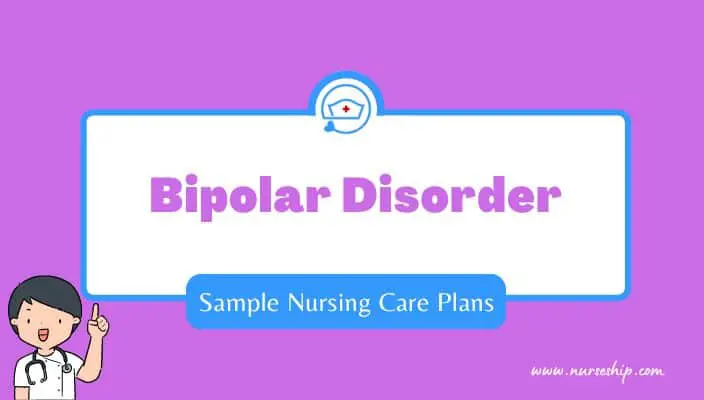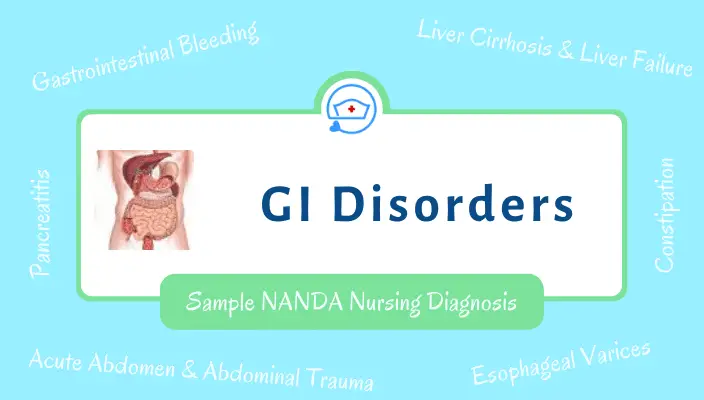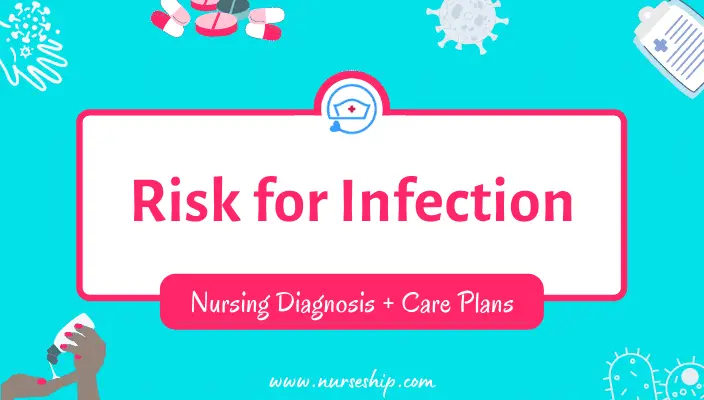Here we’ll formulate sample Bipolar Disorder Crisis nursing care plans based on a hypothetical case scenario.
It will include three Bipolar Disorder nursing care plans with NANDA nursing diagnoses, nursing assessment, expected outcome, and nursing interventions with rationales.
Bipolar Disorder Case Scenario
A 19-year-old female presents to the ED accompanied by her mother. The patient says she “feels great and has no complaints at all,” but the patient’s mother says she thinks her daughter is having a manic episode.
The mother reports the patient hasn’t eaten or slept in over 72 hours and has been extremely hyperactive: pacing around the house, talking non-stop, tearing apart her room to organize, and giving away her laptop and favorite purse as gifts to friends.
Her mother states the patient has been diagnosed with bipolar disorder and has had a suicide attempt in the past.
The patient is prescribed lithium, although her mother is not sure if the patient has actually been taking it.
Upon assessment, the patient is standing up and pacing around the room. She is alert and oriented and states “I have no idea why my mom brought me here because I just feel really energized and motivated and decided to organize my record collection by year which I guess freaked her out.”
The patient is easily distracted and frequently picks up various items around the room. The patient’s temperature is 37.4 ˚C, heart rate is 112 BPM, blood pressure is 123/82 mmHg, respirations are 22 breaths per minute, and SPO2 is 99% on room air.
The patient’s skin and mucous membranes are dry, and skin tenting is noted on the back of the patient’s hand.
Various bruises and cuts are noticed across the patient’s arms and legs. When questioned about these, the patient said she fell a few times while running through the house.
The patient’s lab work is within normal limits, although the patient has a lithium level of 0.2 mEq/L.
The patient is admitted for a manic episode of Bipolar Disorder.
#1 Sample Nursing Care Plan for Bipolar Disorder – Ineffective health management
Nursing assessment
Objective Data:
- The patient is experiencing a manic episode.
- She hasn’t eaten or slept in 72 hours.
Objective Data:
- The patient has not been taking her lithium, as evidenced by a low lithium level of 0.2 mEq/L
Bipolar disorder nursing diagnosis
Ineffective health management related to noncompliance with prescribed medication as evidenced by lithium level of 0.2 mEq/L.
Goal/Desired Outcome
Short-term goal: The patient will agree to take her prescribed dose of lithium.
Long-term goal: The patient will maintain a therapeutic blood level of lithium and will state the importance of taking her medications daily.
Bipolar disorder nursing interventions – Ineffective health management
| Nursing Interventions | Rationales |
| Educate the patient about lithium use. | Lithium is one of the most widely used medications for bipolar disorder. It decreases the incidence of both manic and depressive episodes and is thought to work by strengthening the nerve connections in the brain. Medications that can interact with lithium include ACE inhibitors and NSAIDs. |
| Notify the patient about the normal side effects of lithium use. | Headache, tremors, dry mouth, hair thinning, drowsiness, nausea, and vomiting are expected side effects of lithium usage. |
| Educate the patient about signs of lithium toxicity. | Lithium must be kept within a strict therapeutic range and regular blood work is performed to ensure an appropriate level is maintained. Early signs of lithium toxicity include a loss of appetite, polyuria, polydipsia, confusion, and trouble speaking. Late signs of lithium toxicity include seizures, kidney failure, tachycardia, hyperthermia, coma, and death. |
| If applicable, administer antipsychotics or benzodiazepines. | In the acute phase of mania, antipsychotics and benzodiazepines may be used to control hyperactivity, insomnia, and irritability. Examples of antipsychotics include aripiprazole (Abilify), olanzapine (Zyprexa), and quetiapine (Seroquel). Examples of benzodiazepines include lorazepam (Ativan) and alprazolam (Xanax). |
| Encourage psychotherapy and support groups. | In addition to medications, psychotherapy and support groups are helpful in controlling bipolar symptoms. |
| For treatment-resistant or severe bipolar disorder, consider ECT. | Electroconvulsive therapy has been shown to be helpful for patients who don’t respond to traditional therapy or cannot take medications. |
#2 Sample Nursing Care Plan for Bipolar Disorder – Risk for injury
Nursing assessment
Subjective Data:
- The patient reports falling multiple times.
- She hasn’t eaten or slept in 72 hours.
- She has a history of a previous suicide attempts.
Objective Data:
- The patient appears dehydrated.
- Various cuts and bruises are noted on the patient’s body.
Bipolar disorder nursing diagnosis
Risk for injury related to hyperactivity secondary to mental health disorder as evidenced by reports of falling, various superficial abrasions, and signs of dehydration.
Goal/desired outcome
Short-term goal: The patient will remain safe and free from falls for the duration of the shift.
Long-term goal: The patient will take lithium as prescribed and have no further suicide attempts or manic episodes.
Bipolar disorder nursing interventions – Risk for injury
| Nursing Interventions | Rationales |
| Assess for suicidal ideation and institute suicide precautions if necessary. | Patients with bipolar are at an increased risk of suicide. Risk can be assessed by asking directly if the patient has had thoughts about harming themselves if they have a plan, or how frequently they have suicidal thoughts. |
| Perform skin assessment. | A thorough skin assessment should be documented to assess for injuries (both accidental and self-inflicted). |
| Maintain an environment free of stimulation. | A quiet, low-lighting environment will help minimize anxiety. |
| Provide rest breaks. | Rest is important for patients experiencing a manic episode to prevent exhaustion and death from hyperactivity, dehydration, and lack of sleep. |
| Avoid arguing and utilize de-escalation techniques. | Maintain a calm, firm demeanor and prevent escalation to self-directed or staff-directed violence. |
#3 Sample Nursing Care Plan for Bipolar Disorder – Self-neglect
Nursing assessment
Subjective Data:
- The patient hasn’t eaten or slept in 72 hours.
Objective Data:
- The patient appears dehydrated.
- She has not been taking her lithium, as evidenced by a low lithium level of 0.2 mEq/L.
Bipolar disorder nursing diagnosis
Self-neglect related to hyperactivity secondary to manic episode as evidenced by refusal to eat, drink, take home medications, and sleep.
Goal/desired outcome
Short-term goal: By the end of the shift, the patient will drink several glasses of water and eat a meal.
Long-term goal: The patient will successfully and independently perform activities of daily living at home.
Bipolar disorder nursing interventions – Self-neglect
| Nursing Interventions | Rationales |
| Encourage high-calorie food and drink. | The patient should be frequently encouraged and reminded to eat and drink. High-calorie shakes may be helpful during manic phases. |
| Provide direction and reminders about eating and drinking. | Since the patient is hyperactive and easily distracted, clear directions should be given (i.e. take a bite of the food). |
| Monitor I&O. | Intake and output should be monitored to ensure adequate fluid balance. |
| Assist with ADLs. | In the manic phase, the patient may require help and guidance with ADLs. The patient should be reminded about teeth brushing and bathing, and clear, step-by-step instructions should be given. |
| Encourage sleep. | Providing a sleep-positive environment is important while in the manic phase. Soft music, low-lighting, and avoiding caffeine are a few strategies to encourage sleep. |
| Send patient belongings and valuables home with family. | In the manic phase patients are prone to engage in risky or unwise behaviors such as giving away money or valuable items. Items should be sent home with family to prevent this. |
Conclusion
To conclude, here we have formulated a scenario-based sample nursing care plan for Bipolar Disorder. Prioritized nursing diagnosis includes ineffective health management, risk for injury, and self-neglect.
Additionally, these sample bipolar disorder nursing care plans comprise nursing assessment, NANDA nursing diagnosis, goal, and interventions with rationales.
Recommended Readings & References
Ackley, B., Ladwig, G., Makic, M., Martinez-Kratz, M., & Zanotti, M. (2020). Nursing Diagnoses Handbook: An Evidence-based Guide to Planning Care (12th ed.). Elsevier.
Doenges, M., Moorhouse, M., & Murr, A. (2013). Nurse’s Pocket Guide: Diagnoses, Prioritized Interventions, and Rationales (13th ed.). F. A. Davis Company.
Herdman, T., Kamitsuru, S. & Lopes, C. (2021). NURSING DIAGNOSES: Definitions and Classifications 2021-2023 (12th ed.). Thieme.
Schultz, J., & Videbeck, S. (2013). Lippincott’s Manual of Psychiatric Nursing Care Plans (9th ed.). Wolters Kluwer Health | Lippincott Williams & Wilkins.




